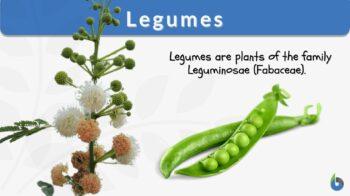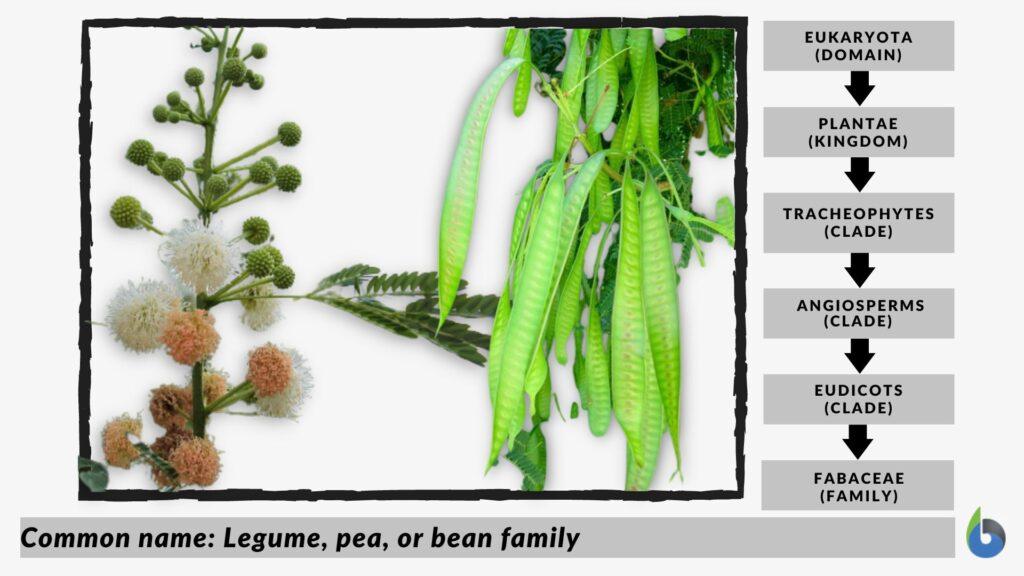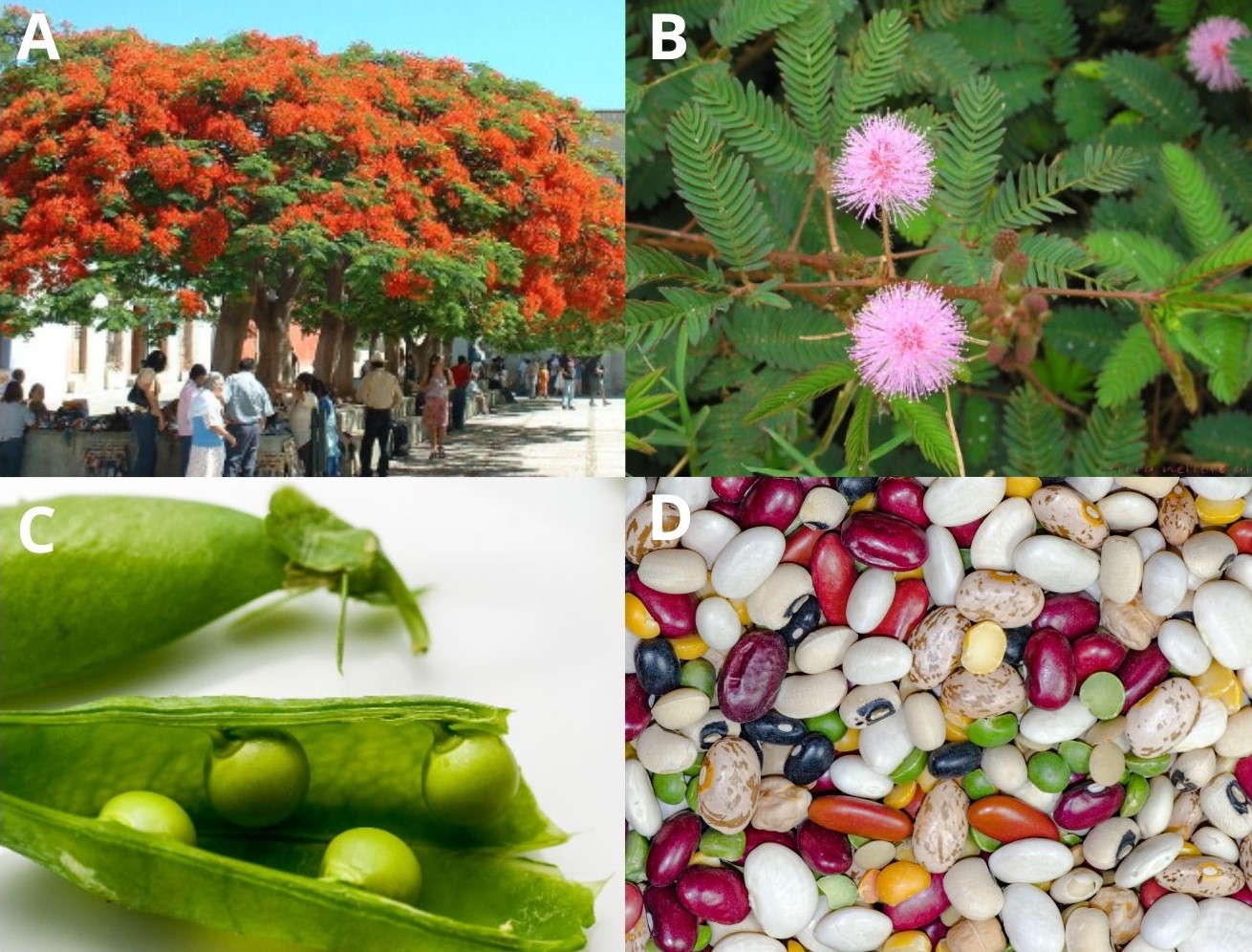
Legumes
n., singular: legume
[ˈlɛɡjuːmz]
Definition: plants of the family Leguminosae (Fabaceae)
Table of Contents
Legumes Definition
Legumes (singular: legume) are plants belonging to the family Leguminosae (Fabaceae). Leguminosae is also called the legume family. They are characterized by having a legume-type of fruit (also referred to as pod) and compound, stipulate leaves. Many of them form root nodules where nitrogen-fixing bacteria reside.
Leguminosae is the third of the largest group of land plants, behind Orchidaceae and Asteraceae. There are about 19,500 species identified in this family. (Ref.1) Many of these species are cultivated and harvested for human and livestock consumption.
In essence, the word “legume” has another meaning in biology. It can also pertain to the fruit or the seed of the Leguminosae family. The term “pulse”, however, is ascribed specifically to the dried seeds harvested from the leguminous fruit crops. Based on this definition, pulses include the various edible seeds, e.g. dry beans, dry peas, chickpeas, and lentils; peanuts and soy are not. (Ref.2)
Etymology: Latin “legūmen”, meaning “bean”.

Types of Legumes
The legume family is comprised of the subfamilies (1) Caesalpinioideae, (2) Mimosoideae, and (3) Faboideae (syn. Papilionoideae). (Ref.3)
- Caesalpinioideae are commonly referred to as the peacock flower subfamily. Many of them are planted as ornamental trees for their aesthetic blooms.
- Mimosoideae are smaller plants with flowers that are not in clusters, and with colored stamens.
- Faboideae is the largest subfamily of legumes. It is what people are most familiar with when mentioning legumes. One of the distinctive features of the members of this subfamily is the “papilionoid” (butterfly-like) floral morphology: two wing petals, two keel petals, and one standard petal. (Ref.3)

Edible and inedible legumes
Legumes may also be grouped as edible or inedible. Edible ones are pea legume, peanut, lentils, chickpeas, lupins, and beans. While these plants are regarded as edible crops, other leguminous species are regarded as weeds but are, nonetheless, legumes, but inedible. Examples are kudzu, gorse, Lupinus sp., Robinia pseudoacacia, and Cytisus scoparius. Some of them produce toxins and therefore can be poisonous, e.g. raw or insufficiently cooked red kidney beans.
List of Legumes
Some of the common plants in the legume family are as follows:
- Alfalfa
- Beans
- Clover
- Carob
- Chickpeas
- Lentils
- Lupins
- Mesquite
- Peanuts
- Peas
- Soybeans
- Tamarind
- Mimosa
What is the Difference Between Beans and Legumes?
Legumes and beans are two different but related terms. Beans are just one of the many types of legumes, both at the plant and at the seed levels. (Ref.4) Similar to a legume that pertains to the plant or the fruit (or seed) of such a plant, a bean could likewise be the plant itself or the seed of such a plant. The genus Phaseolus is commonly called the wild bean plant. There are about 70 species included in this genus. Apart from this genus, though, the seeds of other related plants are also called “beans”, such as soybeans, broad beans, adzuki beans, etc. Even the seeds of the phylogenetically unrelated plant, such as coffee, are referred to as “coffee beans”, primarily because of the morphological resemblance to the true beans.
Is Legume a Vegetable?
In botany, a legume fruit, as the name implies, is a fruit. To be precise, it is a type of simple dry fruit, which means it arises from a single carpel, its mesocarp is dry at maturity, and it dehisces along the seams on two sides to release the seeds. Examples include peas, beans, kudzu, peanuts, and carob. (Ref.5)
In food science, though, it is often regarded as a vegetable — a vegetable crop, in particular. They are being grown agriculturally for their nutritional value. They are high in protein and fiber while low in fat.
Importance of Legumes
Apart from serving as food, they also fulfill a role in crop rotation. The nitrogen-fixing endosymbionts inside the root nodules of the legumes convert nitrogen into other nitrogen-containing compounds that the plants can readily use. Many organisms cannot utilize the nitrogen in the atmosphere. Thus, they derive their nitrogen requirements from the nitrogenous compounds available in the environment. Conversely, certain bacteria and archaea can directly use it. Rhizobium, for instance, can convert atmospheric nitrogen into usable nitrogen-containing compounds, which they provide directly to the roots of legumes. Thus, crop planting became a common practice in agriculture where legumes are included in the crop planting series so as to nourish the soil with different nutrients, including nitrogenous compounds.
Some legumes are important in the industry. Acacia tree, for example, is used for its gums. Phaseolus plant produces phytohaemagglutinin (lectins) that is extracted for its erythrocyte and leukocyte agglutination and mitogenic effects.
Watch this vid about legumes:
Answer the quiz below to check what you have learned so far about legumes.
Further Reading
References
- MAARTEN J.M. CHRISTENHUSZ, & BYNG, J. W. (2020). The number of known plants species in the world and its annual increase. Phytotaxa, 261(3), 201–217. https://www.biotaxa.org/Phytotaxa/article/view/phytotaxa.261.3.1/20598
- What is a Pulse? | Pulse Canada. (2020). Pulsecanada.Com. http://www.pulsecanada.com/about-pulse-canada/what-is-a-pulse/
- Doyle, J. J. (2001). Leguminosae. Encyclopedia of Genetics, 1081–1085. https://doi.org/10.1006/rwgn.2001.1642
- Legumes and Pulses. (2019, October 28). The Nutrition Source. https://www.hsph.harvard.edu/nutritionsource/legumes-pulses/
- Biology Online Editors. (2020, January 27). Fruits, Flowers, and Seeds – Biology Online Tutorial. Biology Articles, Tutorials & Dictionary Online.
https://www.biologyonline.com/tutorials/fruits-flowers-and-seeds
©Biology Online. Content provided and moderated by Biology Online Editors.





